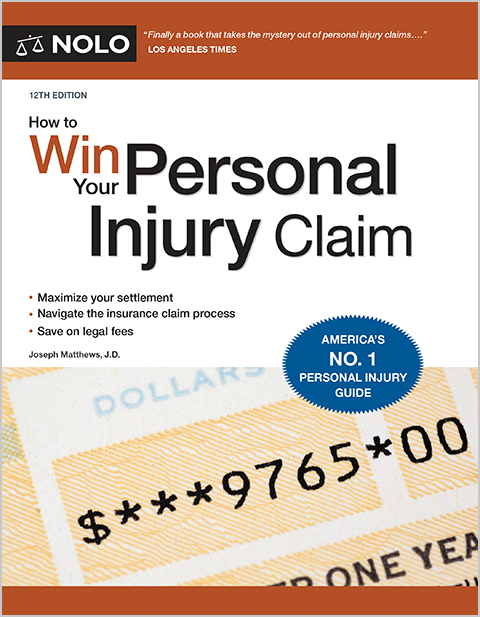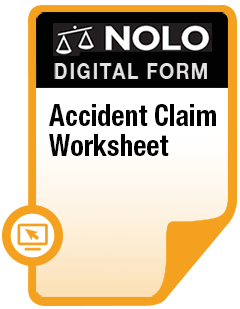Injured in a Massachusetts slip and fall? Find out about the elements of a slip and fall claim, defenses the landowner is likely to raise, the lawsuit filing deadline, and more.
You slipped and fell on some liquid spilled in a grocery aisle. Or you tripped and fell on the uneven pavement of your neighbor's front walk. If you've been hurt in a slip and fall or trip and fall accident like one of these, you might be thinking about an insurance claim or a slip and fall lawsuit to recover compensation ("damages") for your injuries.
You've come to the right place. We walk you through the elements of a Massachusetts slip and fall claim, focusing most of our attention on the issue of fault—who's legally responsible for your injuries. We'll also touch on the statute of limitations, other defenses the landowner might raise, and much more.
The Elements of a Massachusetts Slip and Fall Case
Massachusetts slip and fall claims are grounded in negligence law. Negligence is the failure to be as careful as the circumstances require. But negligence, by itself, isn't enough. To have a slip and fall case, the landowner's negligence must have caused you to suffer an injury.
Massachusetts Negligence Law
To prove a landowner's liability (legal responsibility) for your slip and fall, Massachusetts negligence law requires you to show that:
- the landowner owed you a duty of care
- the landowner breached, or failed to meet, that duty of care
- you suffered an injury, and
- your injury was caused by the landowner's failure to meet the duty of care.
The first two elements—duty of care and breach of that duty—are what the law calls negligence. In a typical slip and fall case, both are hotly contested.
Landowners, tenants, contractors, property managers, easement owners, and others who own or control real estate—we call them all "owners" or "landowners" for the sake of convenience—have a legal duty to keep their property reasonably safe for known or foreseeable visitors. Sometimes, this duty extends to trespassers.
As we'll see, though, duty is a two-way street. Most often, the defendant (the party you're suing) will respond to your claim that they were negligent by arguing that you were negligent, too. This legal defense, called "comparative negligence," gets raised in almost every slip and fall case.
What Is a Duty of Care?
The duty of care is a legal standard—a rule that explains what a landowner should do to be reasonably sure their property is safe for visitors. It says to a landowner "Here's what you must do to avoid legal responsibility for injuries that happen on your property."
In Massachusetts slip and fall cases, a landowner's duty of care arises when:
- there's a dangerous condition on the property, and
- the landowner knows (or in some cases, the landowner should know) about the danger.
What Does the Duty of Care Require?
Under Massachusetts law, the duty of care requires that a landowner use reasonable care to make their property safe for visitors who have permission to be on the property. Different rules (discussed below) apply to trespassers.
But what does that mean? What must the owner actually do to satisfy this duty? Unfortunately, there isn't a single, one-size-fits-all answer to that question. In each case, the landowner's duty depends on the risk of harm that's involved, including the nature and severity of the harm and how likely or foreseeable it is that the harm will occur.
Dangerous conditions that are more likely to cause serious injury or death demand a higher degree of care than those posing only a risk of minor harm. A high likelihood that a harm will come about means the landowner must take greater care than when the likelihood of harm is minimal.
Courts also consider the burdens a duty of care might place on the landowner. How much time and effort is likely to be involved? What will it cost to fix a dangerous condition, or to maintain the property free of a particular hazard? Higher demands are appropriate in situations when a danger foreseeably might result in catastrophic injury or death, but not when the risk of harm is only slight.
In general, the duty of care requires a landowner to:
- periodically inspect their property to discover dangers, and
- either warn visitors about dangerous conditions, or fix those conditions.
Courts Adjust the Duty of Care Based on the Facts
Courts regularly tweak the duty of care based on the facts of a case. For example, when a landowner knows that visitors will be on their property, the law probably expects them to inspect more frequently and be more vigilant about warnings and repairs.
Consider, for example, a retail merchant. They want customers to come to their store every day. For those customers—the law calls them "invitees" or "business invitees"—daily (or even more frequent) inspections might be necessary. By comparison, imagine a homeowner who invites family and friends for a birthday party. To keep the property safe for party guests (in legalese, "licensees"), an inspection shortly before the party might suffice.
What About Trespassers?
As a general rule, Massachusetts landowners owe no duty of care to adult trespassers other than to avoid willful, wanton, or reckless misconduct—intentional wrongdoing that ignores a risk of harm or that's meant to cause harm.
Special rules apply to trespassing children. Kids often are drawn to a property by what the law calls an "attractive nuisance"—things like a swimming pool, a trampoline, or abandoned vehicles. When a landowner knows that kids are trespassing because their property poses an attractive nuisance, they must take reasonable steps to protect the children from harm. This might include fencing the property, placing warning signs, or other safety measures. (See Mass. Gen. Laws ch. 231, § 85Q (2024).)
Finally, like many states, Massachusetts has recreational use laws that limit the liability of landowners who open their property for use without charge to recreational, charitable, educational, and similar users. Generally speaking, people who use the land for these purposes are owed the same duty of care—no willful, wanton, or reckless misconduct—as is owed to trespassers. (See Mass. Gen. Laws ch. 21, § 17C (2024).)
Dangerous Conditions and Landowner Notice
So, when is a landowner required to warn of or fix a dangerous condition? When these two things are true. First, a dangerous condition must exist on the land. Second, the landowner must have known of the danger in sufficient time to warn about or repair it.
Examples of dangerous conditions. Here are some examples of dangerous property conditions:
- uneven surfaces caused, for example, by something like a crack or break in the pavement or walk
- loose or easily movable surface material such as gravel, rocks, or sand
- wet, slushy, snowy, or icy walkways
- stair runs or risers that are larger or smaller than what's typically required by building or safety codes
- torn, frayed, or unsecured carpets or rugs
- accumulations—natural or artificial—of water, snow, or ice
- foreign substances like liquids, foods, or other slipping or tripping hazards on floors
- aisles or walkways occupied or partially blocked by product displays
- tools or equipment left in aisles or walkways
- products spilled on store aisles
- inadequate lighting
- missing or defective railings, handrails, or guardrails, and
- things hanging from shelves or ceilings.
The landowner must have known of the danger. A landowner can't be expected to warn about or fix dangerous conditions when the landowner isn't aware of them. Proving that the landowner had notice of the danger is critical to a slip and fall claim. In most cases, the landowner will deny having had any notice of the danger, or having had notice in enough time to act before you were hurt.
A landowner can be liable if they have either actual notice or constructive notice of a hazard. Proof that the landowner created the condition should be enough to show actual notice. If the landowner didn't create the danger, proving what they actually knew can be a challenge. Here are examples of the kinds of evidence you might look for.
- Prior incident reports and complaints, documenting earlier encounters with the condition.
- Maintenance records, showing prior efforts to deal with the condition.
- Inspection reports from government agencies, recording prior infractions or safety violations related to the condition.
- Surveillance photos or videos, to prove how the condition came to be and how long it had existed.
- Testimony from others who saw the dangerous condition, to find out what they saw and what, if anything, they reported to the landowner.
- Emails, text messages, and other communications indicating that the dangerous condition was known to the landowner or its agents.
- Testimony from the landowner and the landowner's agents, to find out what they knew about the condition and when they knew it.
- Expert witness testimony, which can help to establish, for example, how long a substance likely had been on the floor before you fell on it.
A landowner's constructive notice of the danger also can be enough. You'll need to rely on constructive notice when—as often will be the case—the landowner denies having actually known of it.
The key to constructive notice is proving how long the dangerous condition existed before it injured you. In terms of landowner responsibility, the longer it was there, the better. Once you have an idea of how long the danger existed, you can argue that had the landowner been reasonably careful, they would have inspected the property, discovered the hazard, and fixed it or warned you about it.
(Learn more about proving fault for slip and fall accidents.)
Landowner Defenses: Shifting the Blame to You
In addition to lack of notice, landowners can raise a number of defenses to a slip and fall claim. Two of the most common are:
- you were partly or completely to blame for your injuries, and
- the danger was open and obvious.
You Were to Blame
Your own negligence can be a defense to the owner's legal responsibility. If the accident happened in a contributory negligence state, any negligence on your part—even 1% of the total—defeats your claim entirely. By contrast, when the accident happened in a comparative negligence state like Massachusetts, your share of the blame reduces the damages you can collect.
Massachusetts' "modified" comparative negligence rule. In a "modified" comparative negligence state, your percentage share of the blame reduces your personal injury damages by that amount, but only if you're not mostly responsible for your injury. Under Massachusetts' rule, you can't collect any damages when you're found to be 51% or more at fault.
Suppose, for example, a Massachusetts jury finds that you were 30% at fault for your fall, assigning the remaining 70% of the blame to the defendant. Jurors decide your total damages are $100,000. You can collect $70,000: $100,000 x 70%. But if the jury decides you were 51% or more to blame? You get nothing.
(See Mass. Gen. Laws ch. 231, § 85 (2024).)
What did you do that was negligent? The defendant will look high and low for ways to blame you for the fall. Here are a few of the most common claims.
- You were on a part of the property where visitors aren't allowed, or aren't expected to be.
- You weren't paying attention to where you were walking.
- You were distracted by a child, or your phone, or something else.
- You were wearing footwear that was inappropriate or even unsafe for the situation.
- You were warned of the dangerous condition, or the owner took reasonable steps to protect visitors.
- The dangerous condition was open and obvious.
Open and Obvious Dangers
In many states, landowners aren't responsible for injuries caused by known or "open and obvious" dangers. An open and obvious danger is one that's clearly visible and that should be seen by a reasonable person exercising ordinary care for their own safety. Common examples include accumulations of snow or ice, large objects, and darkness.
In Massachusetts, the fact that a dangerous condition is open and obvious isn't an automatic defense to liability. Visitors must take reasonable steps to protect themselves from obvious dangers. But if the landowner should anticipate that the condition still poses a risk of harm despite its open and obvious nature—visitors might be distracted and not perceive the danger, for instance, or a visitor might be unable to avoid the hazard even with reasonable care—then the landowner still has a duty to warn of the danger or take other steps to minimize the likelihood of injury.
The Slip and Fall Statute of Limitations
A "statute of limitations" is a law that limits your time to file a lawsuit in court. For most Massachusetts slip and fall claims, you have three years from the date you were injured to sue. Different rules might apply when:
- you don't discover your injury right away
- your claim is against the government
- the defendant lives outside of Massachusetts or flees the state to avoid being sued
- the defendant fraudulently conceals your claim from you, or
- you were legally disabled (unable to sue on your own behalf) when you were injured.
(Mass. Gen. Laws ch. 260, § 2A (2024); Mass. Gen. Laws ch. 260, § 9 (2024); Mass. Gen. Laws ch. 260, § 12 (2024); Mass. Gen. Laws ch. 260, § 7 (2024).)
If you're unsure about how much time you have to file a slip and fall lawsuit, speak to a Massachusetts personal injury lawyer right away. Miss the filing deadline and, absent an extension that gives you more time to sue, your slip and fall claim is legally dead. You've lost the right to recover damages for your injuries.
Do You Need a Lawyer for Your Slip and Fall Claim?
To answer that question, ask yourself these questions.
- Are the case facts simple and mostly uncontested? If so, that's a point in favor of giving it a try on your own. On the other hand, when the facts are complicated or murky, or the defendant disputes your version of the story, think about hiring legal counsel. A lawyer can help you find and organize the facts into a coherent, compelling narrative that puts you in the best possible light.
- Are there difficult legal issues involved? Here, we're speaking of legal issues that might sink, or do serious damage to, your case. The statute of limitations is a prime example. So is comparative or contributory negligence, as discussed above. Because comparative negligence is almost guaranteed to be in play in a slip and fall case, your best bet will be to have legal help in your corner.
The defendant will be represented by an insurance company and its attorneys. It won't be a fair fight if you don't have legal counsel, too. Here's how you can find a lawyer who's right for you.
Massachusetts Slip and Fall FAQ
Here are some other questions you might have about your slip and fall case.
Where Will Your Slip and Fall Lawsuit Be Filed?
Your lawyer will file your case in the Massachusetts district court (if your damages are $50,000 or less) or the Massachusetts superior court (if your damages are more than $50,000). In addition to choosing the proper court, your lawyer also must sue in the correct "venue," or location. Typically, that's the court nearest to where the defendant lives or has its main place of business, or where you fell and were injured.
Will Your Case Settle or Will It Go to Trial?
The overwhelming majority of personal injury cases settle without a trial. Yours probably will, too, unless the defendant feels confident a jury will find you were mostly to blame, you weren't badly hurt, or your injuries weren't caused by the fall. You should discuss negotiation and settlement strategies with your lawyer.
How Long Will It Take to Resolve Your Case?
That depends. If the facts aren't disputed, it's clear the landowner was to blame, you've gathered the evidence to support your claim, and your injuries and damages are well documented, your case might settle in several weeks to a few months. If it goes to trial, expect the process to take a year or more, and even longer if there's an appeal. A case can settle at any time during trial preparation or trial.
What Kinds of Damages Can You Collect?
If you win your case, you'll recover what the law calls "compensatory damages." These are meant to compensate you for:
- out-of-pocket losses like medical bills, lost wages, and amounts you pay for replacement household services, and
- things that don't come directly out of your pocket, like pain and suffering, emotional distress, and disability.
(Learn more about how insurance companies value injury cases.)
Find Out About Massachusetts Personal Injury Laws
Your slip and fall claim is a type of personal injury case. You can learn more about the laws we've covered here, as well as other Massachusetts personal injury laws that might impact your claim.


